The really easy guide to pruning hydrangeas
The first question anyone asks about pruning hydrangeas is ‘when should I prune?’
The Royal Horticultural Society says that you should prune hydrangeas in late winter or early spring. That’s February or March in most of the UK.
Others will say you shouldn’t prune until March. The dried hydrangea flower heads give the buds below some protection from very bad weather. A sudden bout of snow and ice in early spring may damage the newly exposed buds.
However, the late great Christopher Lloyd always said that there were two times to do any gardening job.
One is the best time. The other is when you’ve got time.
Tamsin Westhorpe of Stockton Bury gardens in Herefordshire prunes her hydrangeas in January. That’s mid to late winter. She prunes early because Stockton Bury gardens open on April 1st and she can’t leave too many jobs to the last minute.
You know your own weather.
So the simple answer is that if you regularly get very bad spells of snow and ice in late winter or early spring, then leave pruning your hydrangeas until later. The occasional late frost is unlikely to do much damage, but a prolonged bout of freezing weather could damage newly exposed buds.
But if you generally have reasonably mild winters, then you can prune your hydrangeas when it is most convenient to do so. One good sign is when new green growth is emerging from the buds.

If you have an evergreen climbing hydrangea (Hydrangea seemannii), then prune immediately after it flowers in summer.
The really easy way to prune hydrangeas
Hydrangeas are pruned differently according to what type of hydrangea they are.
Hydrangea expert Roger Butler of Signature Hydrangeas told me that the number one reason for hydrangeas not flowering is that they haven’t been pruned properly.
So if you’re nervous about pruning hydrangeas or can’t identify your hydrangeas properly, there is one method that will always work.
Simply dead head the hydrangeas, snipping off the dried flower head to the first pair of fat buds below it. That means you take the flower off, but leave the buds on. They should give you your next lot of flowers.
This means you are working from the top of the stem, going downwards.
Then take out any dead stems or any stems that are crossing over. Take these out from the base of the plant.
That’s all there is to it. It’s a minimalist approach to pruning hydrangeas, but it will work.
My friend, Emma, who has a magnificent display of hydrangeas, has even whizzed over her hydrangeas with a chain saw. I don’t recommend this, but it’s a thought.
Pruning hydrangeas perfectly – different types need different methods
The reason why some hydrangeas are pruned differently from others is that some flower on ‘old’ wood. Others flower on new growth.
Flowering on new wood means that the plant grows the stem with the flower on it within one year. If you prune them back in spring, they’ve still got time to grow new wood with buds on it.
Plants that flower on old wood set their buds last year. So if you chop them back too far in spring, you could be cutting off the buds. You wouldn’t have any flowers this year.
That’s why simply dead heading back to the first set of buds works for both plants flowering on old wood and those flowering on new. You’re not removing any new buds, regardless of when they were made.
But sometimes hydrangeas do look better with a ‘proper’ prune.
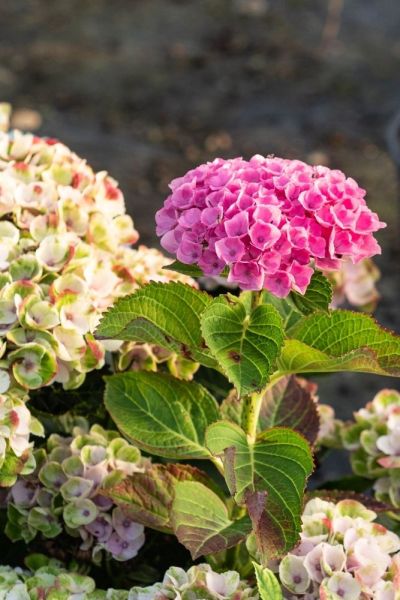
The hydrangeas with round heads, covered with tiny ‘petals’, are called mop heads (Hydranea macrophylla). Most flower on old wood or a mix of old and new wood.
Once you’ve learned the basic pruning method, try one step further and start to think about shaping your hydrangea and where you want the flowers.
I asked garden designer Posy Gentles for her advice. Posy also restores and renovates gardens. Good pruning is a big part of turning an overgrown muddle into a beautiful garden.
How to tell new wood from old wood
Posy says that the new wood is darker than the old wood.
And the newest wood of all are the stems which are tipped with a single leaf bud. Don’t cut these back.
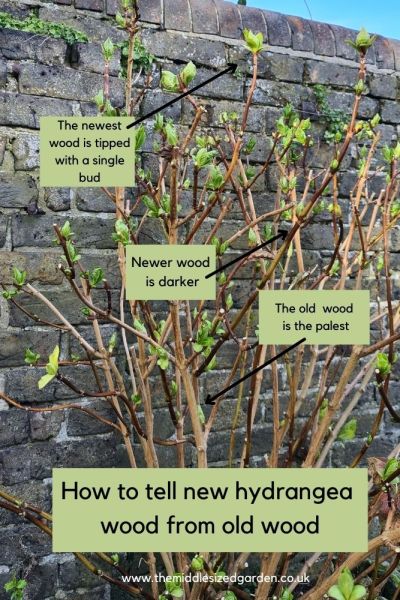
It’s important to know which is the new wood and which is the old when you’re pruning hydrangeas. The new wood is darker and the old wood is quite pale.
The three ways to prune hydrangeas
When it comes to pruning hydrangeas, there are three categories. The first are hydrangeas that need little or no pruning.
The second category benefit from regular shaping, usually in early spring.
The third category can be cut almost down to the ground, also in early spring.
How to prune oakleaf hydrangeas
Firstly, some hydrangeas need only minimal pruning. Just do that basic dead heading and removing dead or crossing stems.
These include oakleaf hydrangeas (Hydrangea quercifolia). If you do want to give them a major prune, only do this immediately after the flowers have faded, because they flower on old wood. But you can do the light tidy up in spring or you can simply leave them alone.
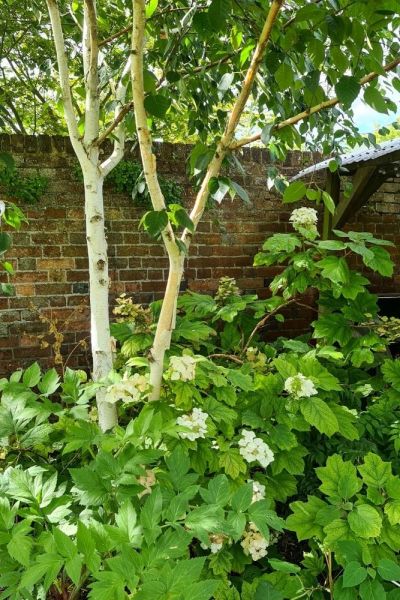
This is an oakleaf hydrangea (Hydrangea quercifolia). It’s happy with minimal pruning. It’s called oakleaf because the leaves resemble oak leaves.
The evergreen climbing hydrangea (Hydrangea seemannii) also fits into this category. Climbers often climb further than you want to. So if Hydrangea seemannii is climbing into your gutters or covering a window or door, you can cut that back any time. You don’t want flowers there anyway, so it doesn’t matter when you cut it back.
How to prune mophead and lacecap hydrangeas
Hydrangea macrophylla are commonly known as the mophead and lacecap hydrangeas. These usually flower on old wood. So if you cut off too much or prune at the wrong time, you can lose this year’s flowers. Don’t let that intimidate you, though.
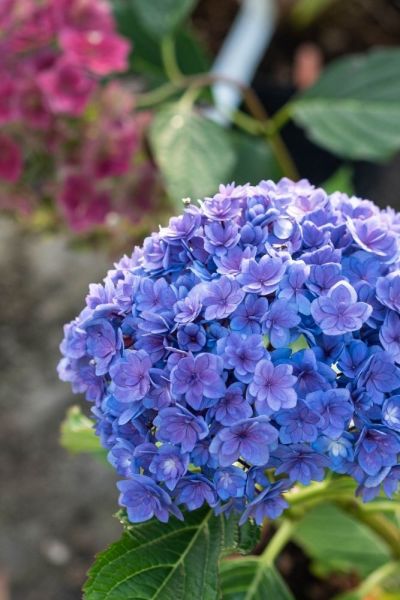
An unknown blue mophead hydrangeas. Mopheads are the only hydrangeas that go blue, and you need to grow them in the right soil. Also only some varieties turn blue.
Posy says that good pruning makes a big difference in a garden.
Posy explained how she pruned two hydrangeas in her garden. One is quite an old lacecap hydrangea which had got congested over the years.
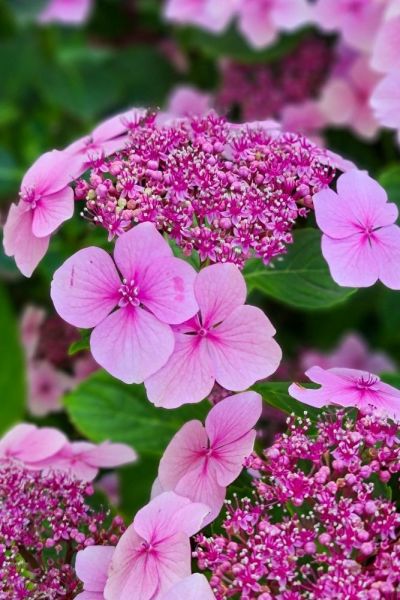
Lacecap hydrangeas have tiny little flowers in the centre and a ring of sterile ‘petals’ around the outside.
‘Look at the overall shape. If you only ever dead head down to the first set of fat buds, then you’ll get flowers round the edge and a tangled mess in the middle.’
Posy wants an even display of flowers all round the shrub, with flowers lower down at the front and higher at the back, to give the hydrangea a nice rounded shape.
She suggests you start with looking down into the shrub, to see where you could cut thicker, paler older stems out from the base. That will give new growth a chance. Cut up to a third out, although you may not need to remove that much.
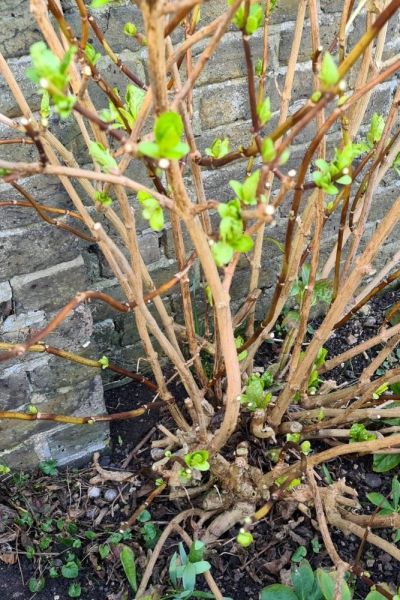
Look down into the base of the shrub. You can spot thicker, older wood and remove it from there.
In order to get a nice rounded shape, she cuts back harder at the front, to the second or third pair of fat buds. These also have flowers.
She also removes any older stems that have been pruned back so many times, they’ve grown into a less attractive shape.
How high do you want your hydrangea?
Posy took a slightly different approach to the second hydrangea, a mophead.
This one adds height and a sense of division around half way down the garden.
To achieve this she leaves most of the old wood framework where she needs the height, simply dead heading back to the first two fat buds and removing any dead wood.
She’ll usually take out one of these taller stems completely from the ground, to allow space for a new tall stem to grow. But to keep the height, she leaves the others.
How to prune Annabelle and Incrediball hydrangeas
The third category are the hydrangeas that can be cut almost completely to the ground.
This includes Hydrangea paniculata and Hydrangea arborescens (often known as smooth hydrangeas).
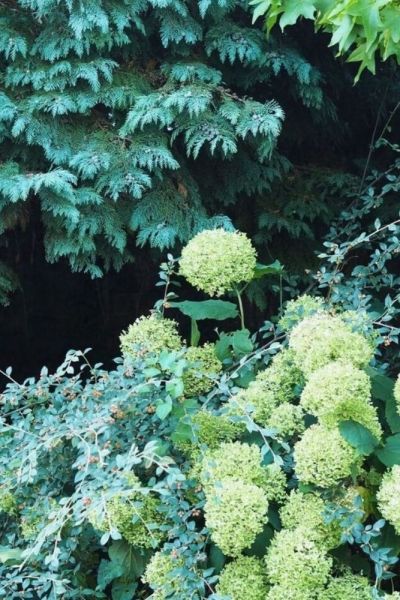
The big white ball heads of Hydrangea arborescens ‘Annabelle’.
‘Annabelle’ is one of the most popular hydrangeas today as is Incrediball.
You can either give paniculata or arborescens hydrangeas the simple basic hydrangea trim. Or you can cut them down to around 10” above the ground in spring.
At this point, it’s also a good idea to cut out any congested or crossing stems.
Your hydrangea should sprout new growth with big flower heads. Sometimes the stems will be quite slender, however, so it may need supporting.
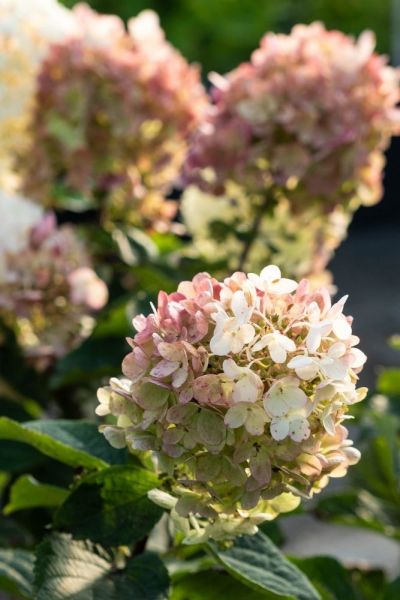
Hydrangea paniculata ‘Fraise Melba’
How do I prune hydrangeas in pots?
Prune hydrangeas in pots the same as you would if they were planted in the ground.
So find out what kind of hydrangea they are. Then think about what shape you want them to be.
Prune accordingly.

What happens if I don’t prune my hydrangeas?
If you forget to prune your hydrangeas for just one year, you probably won’t notice.
But after a few years, your hydrangea may get too big, too tangled or its flowers will be smaller and less showy.
You can restore it to a beautiful shape by pruning it properly, but it may take a few years to get the shape back.
Equipment for pruning hydrangeas
You probably only need a good pair of secateurs, but make sure they are sharp. I bought a pair of Felco secateurs nearly twenty years ago. They’re still going strong.
Even good secateurs go blunt after a season of use, so you can sharpen them with a sharpening stone.
If there’s a particularly thick old stem, you may need loppers. I was sent Wilkinson Sword Ultra-light Loppers free for review several years ago. I really like them, and they’re still going strong.
And I think it’s worth trying to protect your fingers with a pair of gloves. I have, in the past, snipped quite deeply into my own finger. So be careful! I always buy Showa gloves, although I’ve also been given Fiskars gloves free for review and have found them good, too.
For more recommendations on garden tools, see the 7 essential garden tools every gardener should have.
Note that links to Amazon are affiliate, see disclosure.
More about growing hydrangeas
I visited one of the top hydrangea growers in the UK, Signature Hydrangeas, to find out what you really need to know about growing hydrangeas.
And because there are so many myths around hydrangeas, I also asked Naomi Slade, author of the beautiful book Hydrangeas, to help me to sort the myths from the facts.
Pin to remember how to prune hydrangeas
And do join us, see here for a free weekly email with tips, ideas and inspiration for your garden.

























I pruned mine early this year what did i do wrong i only had 3 flowers on 1 2 on the other
The most common reason for hydrangeas not flowering is that the pruning took too much off. Just remove any spent flower heads and any stems that are crossing over or look dead, but don’t cut it back this year and see if that improves things. You may also find it helpful to apply some rose fertiliser (follow the instructions on the packet as if they were roses). Good Luck.
I have three hydrangea in various positions and they have really got so big and out of control. What is the best way of cutting back without causing to much damage . Thanks in advance.
Don’t worry too much about it. If parts of the hydrangeas are going where you don’t want them to go, simply cut off those stems at the base. If you cut too much off a hydrangea, you’ll lose next year’s flowers but that doesn’t kill the hydrangea, and the flowers will probably be back the year after. I’d suggest reducing the height and size to what you want and hoping it works out.
I have a potted mop head that I got for my birthday years ago. Last year I had to leave it with a friend over summer. It was super hot in the UK, they also left for a month and the hydrangea was almost completely dead by Sept. During winter it got some frost also which did not help but still, somehow I managed to revive it this spring. The only thing is that now it has just a few really long, thin stems and made some small (although quite a few) flowers. How and when can I trim it to get a shorter, sturdier stem to help it grow more bushy? Thank you.
I’d suggest pruning it at the normal time and in the normal way for that hydrangea and then taking a few (one third or less) of the thin whippy stems out completely from the base, so that the plant can concentrate on growing fewer stronger stems. Fingers crossed!
Thank you! Finally someone has made pruning hydrangeas easy and simple to understand! So grateful! I was scared to prune my oak leaf, now I can approach the beast without fear.
Thank you! Happy pruning.
I have a huge over grown variety upright tall bush that is preventing the access to a driveway it summer June and tried cutting it back as they can access . How much can I take back in June?
It’s difficult to say as June is usually a bit late for cutting back hydrangeas, but personally I would cut back whatever needs to be cut back as access to the driveway is more important than whether it flowers or not. Cutting back part of it won’t kill it but you probably won’t get as many flowers. It might also be worth digging it up and planting something smaller there.
Thanks so much. I took mine from a pot this year in the spring and dreaded killing it but it flowered superbly so I don’t want to lose it now.
Thank you for this – it’s very clear. But can you advise me what I can do with some tiny hydrangeas I planted last year (mop heads). They only grew one stem each although that did produce a flower. How can I encourage more stems to develop? Thank you
I’m not personally familiar with very small hydrangeas but I think the most sensible thing would be to give them some fertiliser. It may be that they need a little time to adjust and will grow more stems this year. I hope that helps.
Thank you
Hello! When you talk about cutting down to first buds, do you mean first buds from the base of the stem, or first buds from the top of the stem? Thankyou.
The first bud below the dead flower. So you are working from the top downwards. If you want to shape the shrub, you can cut down to the buds near the base, but if a frost comes along and damages them, you won’t have another bud underneaath to take over.